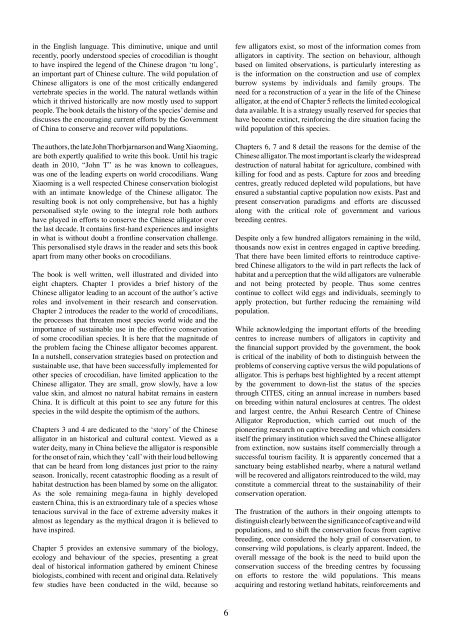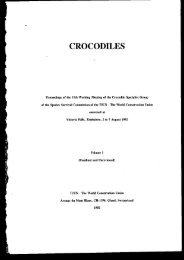size: 992KB - Crocodile Specialist Group
size: 992KB - Crocodile Specialist Group
size: 992KB - Crocodile Specialist Group
Create successful ePaper yourself
Turn your PDF publications into a flip-book with our unique Google optimized e-Paper software.
in the English language. This diminutive, unique and until<br />
recently, poorly understood species of crocodilian is thought<br />
to have inspired the legend of the Chinese dragon ‘tu long’,<br />
an important part of Chinese culture. The wild population of<br />
Chinese alligators is one of the most critically endangered<br />
vertebrate species in the world. The natural wetlands within<br />
which it thrived historically are now mostly used to support<br />
people. The book details the history of the species’ demise and<br />
discusses the encouraging current efforts by the Government<br />
of China to conserve and recover wild populations.<br />
The authors, the late John Thorbjarnarson and Wang Xiaoming,<br />
are both expertly qualified to write this book. Until his tragic<br />
death in 2010, “John T” as he was known to colleagues,<br />
was one of the leading experts on world crocodilians. Wang<br />
Xiaoming is a well respected Chinese conservation biologist<br />
with an intimate knowledge of the Chinese alligator. The<br />
resulting book is not only comprehensive, but has a highly<br />
personalised style owing to the integral role both authors<br />
have played in efforts to conserve the Chinese alligator over<br />
the last decade. It contains first-hand experiences and insights<br />
in what is without doubt a frontline conservation challenge.<br />
This personalised style draws in the reader and sets this book<br />
apart from many other books on crocodilians.<br />
The book is well written, well illustrated and divided into<br />
eight chapters. Chapter 1 provides a brief history of the<br />
Chinese alligator leading to an account of the author’s active<br />
roles and involvement in their research and conservation.<br />
Chapter 2 introduces the reader to the world of crocodilians,<br />
the processes that threaten most species world wide and the<br />
importance of sustainable use in the effective conservation<br />
of some crocodilian species. It is here that the magnitude of<br />
the problem facing the Chinese alligator becomes apparent.<br />
In a nutshell, conservation strategies based on protection and<br />
sustainable use, that have been successfully implemented for<br />
other species of crocodilian, have limited application to the<br />
Chinese alligator. They are small, grow slowly, have a low<br />
value skin, and almost no natural habitat remains in eastern<br />
China. It is difficult at this point to see any future for this<br />
species in the wild despite the optimism of the authors.<br />
Chapters 3 and 4 are dedicated to the ‘story’ of the Chinese<br />
alligator in an historical and cultural context. Viewed as a<br />
water deity, many in China believe the alligator is responsible<br />
for the onset of rain, which they ‘call’ with their loud bellowing<br />
that can be heard from long distances just prior to the rainy<br />
season. Ironically, recent catastrophic flooding as a result of<br />
habitat destruction has been blamed by some on the alligator.<br />
As the sole remaining mega-fauna in highly developed<br />
eastern China, this is an extraordinary tale of a species whose<br />
tenacious survival in the face of extreme adversity makes it<br />
almost as legendary as the mythical dragon it is believed to<br />
have inspired.<br />
Chapter 5 provides an extensive summary of the biology,<br />
ecology and behaviour of the species, presenting a great<br />
deal of historical information gathered by eminent Chinese<br />
biologists, combined with recent and original data. Relatively<br />
few studies have been conducted in the wild, because so<br />
few alligators exist, so most of the information comes from<br />
alligators in captivity. The section on behaviour, although<br />
based on limited observations, is particularly interesting as<br />
is the information on the construction and use of complex<br />
burrow systems by individuals and family groups. The<br />
need for a reconstruction of a year in the life of the Chinese<br />
alligator, at the end of Chapter 5 reflects the limited ecological<br />
data available. It is a strategy usually reserved for species that<br />
have become extinct, reinforcing the dire situation facing the<br />
wild population of this species.<br />
Chapters 6, 7 and 8 detail the reasons for the demise of the<br />
Chinese alligator. The most important is clearly the widespread<br />
destruction of natural habitat for agriculture, combined with<br />
killing for food and as pests. Capture for zoos and breeding<br />
centres, greatly reduced depleted wild populations, but have<br />
ensured a substantial captive population now exists. Past and<br />
present conservation paradigms and efforts are discussed<br />
along with the critical role of government and various<br />
breeding centres.<br />
Despite only a few hundred alligators remaining in the wild,<br />
thousands now exist in centres engaged in captive breeding.<br />
That there have been limited efforts to reintroduce captivebred<br />
Chinese alligators to the wild in part reflects the lack of<br />
habitat and a perception that the wild alligators are vulnerable<br />
and not being protected by people. Thus some centres<br />
continue to collect wild eggs and individuals, seemingly to<br />
apply protection, but further reducing the remaining wild<br />
population.<br />
While acknowledging the important efforts of the breeding<br />
centres to increase numbers of alligators in captivity and<br />
the financial support provided by the government, the book<br />
is critical of the inability of both to distinguish between the<br />
problems of conserving captive versus the wild populations of<br />
alligator. This is perhaps best highlighted by a recent attempt<br />
by the government to down-list the status of the species<br />
through CITES, citing an annual increase in numbers based<br />
on breeding within natural enclosures at centres. The oldest<br />
and largest centre, the Anhui Research Centre of Chinese<br />
Alligator Reproduction, which carried out much of the<br />
pioneering research on captive breeding and which considers<br />
itself the primary institution which saved the Chinese alligator<br />
from extinction, now sustains itself commercially through a<br />
successful tourism facility. It is apparently concerned that a<br />
sanctuary being established nearby, where a natural wetland<br />
will be recovered and alligators reintroduced to the wild, may<br />
constitute a commercial threat to the sustainability of their<br />
conservation operation.<br />
The frustration of the authors in their ongoing attempts to<br />
distinguish clearly between the significance of captive and wild<br />
populations, and to shift the conservation focus from captive<br />
breeding, once considered the holy grail of conservation, to<br />
conserving wild populations, is clearly apparent. Indeed, the<br />
overall message of the book is the need to build upon the<br />
conservation success of the breeding centres by focussing<br />
on efforts to restore the wild populations. This means<br />
acquiring and restoring wetland habitats, reinforcements and<br />
6

















